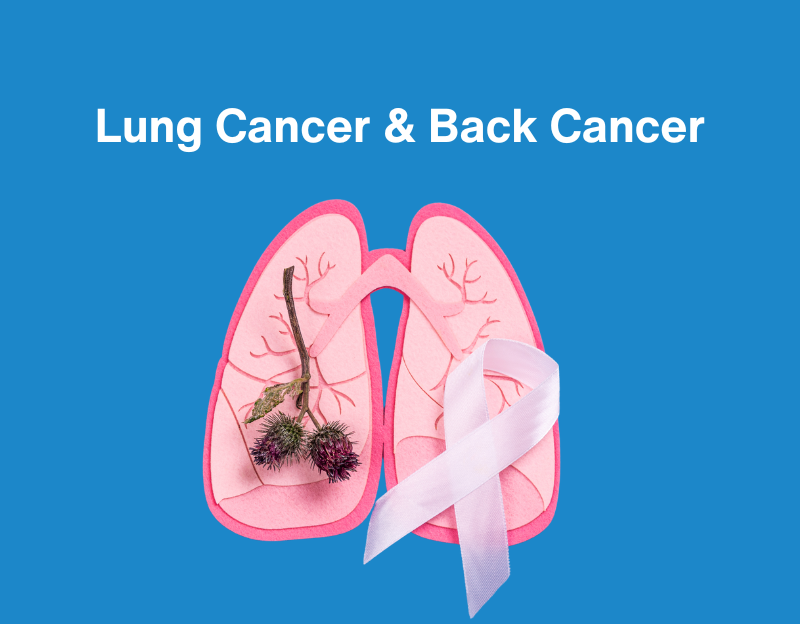
30 Oct, 2024

30 Oct, 2024

This article is medically reviewed by Dr Chandrasekhar Prasad Singh, Consultant - Medical Oncology, HCG-Abdur Razzaque Ansari Cancer Hospital, Ranchi.
Lung cancer is the most common cause of cancer-related deaths globally. Lung cancer occurs when there is uncontrolled growth of abnormal lung cells, which may develop into tumors. There are two primary types of lung cancer: non-small cell lung cancer (NSCLC) and small cell lung cancer (SCLC).
Even though the primary risk factor is smoking, many cases of lung cancer occur in non-smokers. The stage of cancer is one of the critical factors that decide the disease prognosis. Some treatments include surgery, chemotherapy, radiation therapy, immunotherapy, and targeted therapy.
Many patients with lung cancer experience back pain. Studies reported an association between lung cancer and back pain. The internet is flooded with questions like, “What does back pain from lung cancer feel like?” or “Is back pain a symptom of cancer?”
In this article, we are trying to answer those burning questions.
Some of the common symptoms and signs of lung cancer are:
Lung cancer and back pain may be associated because of the following mechanisms:
Some of the diagnostic techniques for back pain in lung cancer are:
In most cases, a comprehensive lung cancer treatment plan focuses on treating the disease as well as the symptoms caused by it. Removing or delbulking tumors through surgery, shrinking tumors through radiation therapy or chemotherapy, or killing them through different treatment approaches can reduce back pain caused by lung cancer. However, in some cases where the patient is terminal, pain medications may be recommended to manage the back pain.
That said, the following are the different treatment approaches available for lung cancer and the back pain caused by it.
Back pain in lung cancer patients is often managed with medications, such as steroids and bisphosphonate drugs. Depending on the severity of the pain, the doses may vary.
A nerve block is an injection that combines a local anesthetic and steroids. When injected into the back, nerve blocks can temporarily or permanently relieve pain.
In some cases, spine surgery may be recommended to reduce back pain in lung cancer patients. These procedures help in decompressing or restabilizing the spine. However, the prognosis of this approach is poor.
Similar to any other category of cancer, palliative care in lung carcinoma also focuses on providing relief from symptoms and improving the quality of life of the patient. The techniques include:
1. Symptom Management: Pain, breathlessness, and coughing are managed by medications. Other techniques, such as oxygen therapy and relaxation exercises, may also be used.
2. Emotional and Psychological Support: Counseling for anxiety, depression, and fear is done for patients, and family members are educated on such problems.
3. Spiritual and Cultural Needs: Most patients in India seek comfort through spiritual practices, such as meditation or prayer, which can have a significant calming effect.
4. Holistic Care: Holistic care includes nutritional support and physical therapy to enhance strength and alleviate pain in various parts of the body.
Lung cancer prevention measures include:
Chest X-rays may be used for screening for lung cancer in high-risk populations but were not shown to improve survival. Low-dose CT scans are currently only recommended for at-risk patients, which include smokers or ex-smokers.
The evidence has shown that an annual low-dose CT scan reduces lung cancer mortality through the detection of the disease before the onset of symptoms.
Some factors can be avoided to reduce the risk of lung cancer. The significant risk factors include smoking cigarettes, cigars, or pipes, exposure to secondhand smoke, a family history of lung cancer, HIV infection, environmental risks, and beta-carotene supplements in heavy smokers.
The protective factors for lung cancer include not smoking, quitting smoking, reducing exposure to workplace hazards, and lowering radon exposure.
Lung cancer is a life-threatening condition with symptoms such as persistent cough, chest pain, inability to breathe, unexplained weight loss, or fatigue. Lung cancer and back pain have a connection.
This connection may be because of pressure from the tumor, compression of nerves because of the presence of cancer, metastasis, and inflammation. It may be diagnosed by imaging techniques such as X-ray, CT, MRI, and PET scans. Treatment techniques include surgery, chemotherapy, targeted therapy, immunotherapy, and radiation therapy.
Lung Cancer - StatPearls - NCBI Bookshelf
Understanding cough and its management in lung cancer
Chronic Cough - StatPearls - NCBI Bookshelf
Dyspnea Management in Early Stage Lung Cancer: A Palliative Perspective - PMC
Clinical Management of Pain in Advanced Lung Cancer - PMC
Red flags to screen for malignancy in patients with low‐back pain - PMC
Surgical Treatment of Lung Cancer
Radiation Therapy for Small Cell Lung Cancer
Lung Cancer Early Detection | Lung Cancer Screening | American Cancer Society
Lung Cancer Prevention - NCI
Author Bio : Dr. Chandrashekhar Prasad Singh
Consultant - Medical Oncology
MBBS, MD (Medicine), DNB (Medical Oncology)
Dr. Chandrashekhar is an experienced medical oncologist who specializes in the management of breast, thoracic, and GI tract malignancies. He is available for consultation at HCG-Abdur Razzaque Ansari Cancer Hospital, a leading cancer hospital in Ranchi. He graduated with an MD degree and a gold medal and has multiple publications in medicine in renowned Indian and international journals. His approach to cancer care is patient-centric, and he strives to provide the best care possible for his patients.